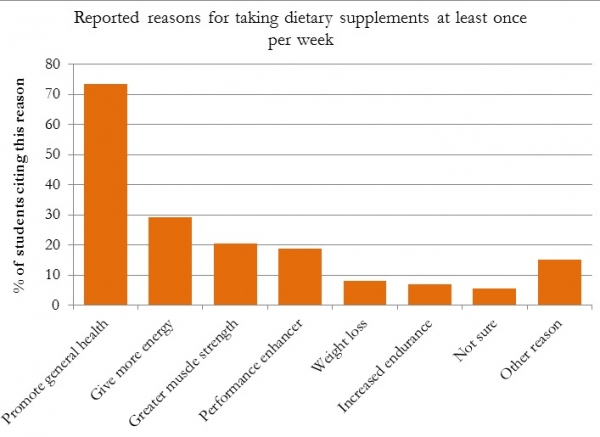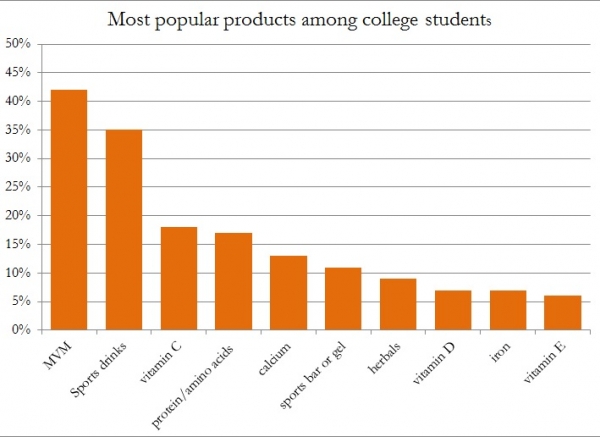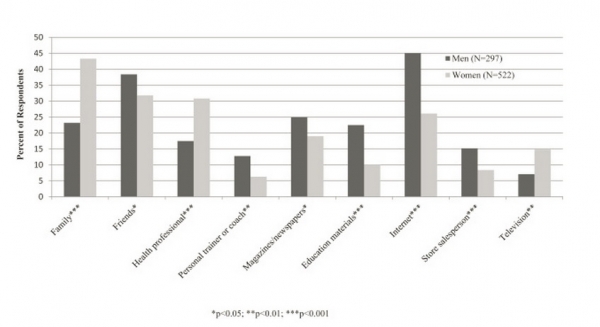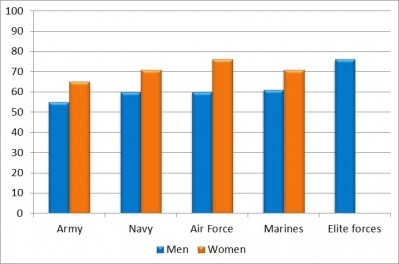College students more likely than general population to use dietary supplements, says survey

In addition, 12% of the 1,248 students surveyed consumed five or more supplements a week, according to findings published in Clinical Nutrition.
The top three reasons for dietary supplement (DS) use among the students were listed as ‘to promote general health’, ‘to give more energy’, and ‘for greater muscle strength (see figure below), reported the authors led by Harris Lieberman from the Military Nutrition Division, United States Army Research Institute of Environmental Medicine .
Concern
While the news may be positive for the industry, the authors view the data negatively. “The apparent overuse of DS by college students is of particular concern because many habits established in college appear to persist through life,” they wrote.
“Although taking DS with no actual benefit may cause little direct physical harm unless they are adulterated, which does occur regularly, there are potentially a variety of negative consequences of consuming large amounts of such DS.
“In this report, we document that college students spend substantial amounts of money on DS, and over the course of a lifetime, this will amount to thousands of dollars.”
According to the data, the mean monthly expenditure on supplements by users was $17, with 19.5% of students spending $30 or more per month on products. Male students typically spent more than females, while older students spent more than younger students.
“Another possible negative consequence of use of unnecessary DS is that individuals may incorrectly perceive them to be a substitute for other healthy behaviors,” they wrote.
Survey details
Lieberman and his co-workers surveyed over 1,200 students from the University of Massachusetts Amherst, Kent State University, California State University Fullerton, Louisiana State University, and Tufts University.
“Although young people are frequently the target of advertising for DS, and specific products are formulated for the youth market, limited information on patterns of use, reasons for use, and predictors of DS intake is available for this population,” they explained.
The data indicated that multivitamins were the most popular supplements used, followed by sports drinks (although not strictly a supplement), vitamin C, and protein/ amino acids (see figure below).
The main sources of information about supplements are displayed in the figure below. For male students, the internet was the leading source of information about supplements, followed by friends and magazines/newspapers. On the other hand, the leading source for the female students was family, followed by friends and health professionals.
“Students frequently consume DS in spite of the lack of scientific evidence to support their use and the possibility of experiencing adverse events,” wrote the authors. “Students should be educated to consume healthy diets consistent with accepted nutrition policies and discouraged from substituting DS for poor nutritional choices, so that lifelong healthy eating habits are established in early adulthood.”
The other authors were affiliated with the Samueli Institute, Abt Associates, Inc., the Medical University of South Carolina, the University of North Carolina, California State University, Kent State University, Louisiana State University, and Natick Soldier Research.
Source: Clinical Nutrition
October 2015, Volume 34, Issue 5, Pages 976–985, doi: 10.1016/j.clnu.2014.10.010
“Patterns of dietary supplement use among college students”
Authors: H.R. Lieberman, B.P. Marriott, C. Williams, D.A. Judelson, E.L. Glickman, P.J. Geiselman, L. Dotson, C.R. Mahoney

















